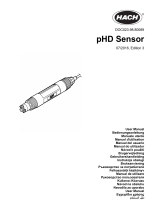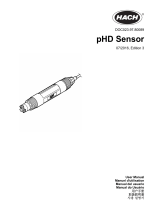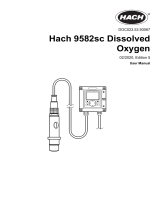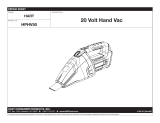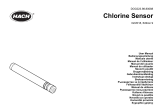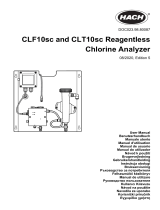Page is loading ...

Model Solu Comp Xmt-A-FF/FI
FOUNDATION
®
Fieldbus Chlorine, Dissolved Oxygen, and Ozone
Transmitter
Instruction Manual
PN 51-Xmt-A-FF/FI/rev.G
December 2009

ESSENTIAL INSTRUCTIONS
READ THIS PAGE BEFORE PROCEEDING!
Rosemount Analytical designs, manufactures, and tests its products to meet many national and international
standards. Because these instruments are sophisticated technical products, you must properly install, use, and
maintain them to ensure they continue to operate within their normal specifications. The following instructions
must be adhered to and integrated into your safety program when installing, using, and maintaining Rosemount
Analytical products. Failure to follow the proper instructions may cause any one of the following situations to
occur: Loss of life; personal injury; property damage; damage to this instrument; and warranty invalidation.
• Read all instructions prior to installing, operating, and servicing the product. If this Instruction Manual is not the
correct manual, telephone 1-800-654-7768 and the requested manual will be provided. Save this Instruction
Manual for future reference.
• If you do not understand any of the instructions, contact your Rosemount representative for clarification.
• Follow all warnings, cautions, and instructions marked on and supplied with the product.
• Inform and educate your personnel in the proper installation, operation, and maintenance of the product.
• Install your equipment as specified in the Installation Instructions of the appropriate Instruction Manual and per
applicable local and national codes. Connect all products to the proper electrical and pressure sources.
• To ensure proper performance, use qualified personnel to install, operate, update, program, and maintain the
product.
• When replacement parts are required, ensure that qualified people use replacement parts specified by
Rosemount. Unauthorized parts and procedures can affect the product’s performance and place the safe
operation of your process at risk. Look alike substitutions may result in fire, electrical hazards, or improper
operation.
• Ensure that all equipment doors are closed and protective covers are in place, except when maintenance is
being performed by qualified persons, to prevent electrical shock and personal injury.
About This Document
This manual contains instructions for installation and operation of the Model Solu Comp Xmt-
A-FF/FI Dissolved Oxygen, Chlorine, and Ozone Transmitter.
The following list provides notes concerning all revisions of this document.
Rev. Level
Date Notes
A 10/04 This is the initial release of the product manual.
D 9/05 Add Foundation fieldbus agency approvals and FISCO version.
E 2/06 All Foundation Fieldbus and FISCO drawings added, pp. 20-37. Added
six languages in description and specifications, and included model
option -FI in section 1.0, page 1.
F 6/08 Update warning labels and drawings
G 12/09 Update DNV logo and company name
CAUTION
If a Model 375 Universal Hart
®
and FOUNDATION
®
Fieldbus Communicator is used with these
transmitters, the software within the Model 375 may
require modification.
If a software modification is required, please contact
your local Emerson Process Management Service
Group or National Response Center at
1-800-654-7768.
WARNING
EXPLOSION HAZARD
DO NOT OPEN THE WHILE CIRCUIT IS LIVE
DO NOT RUB OR CLEAN WITH SOLVENTS.

5. Choose the desired language. Choose >> to show more choices.
6. Choose type of measurement: Oxygen, Ozone, Free Chlorine, Total Chlorine, or
Monochloramine. To see more choices, move the cursor to >> and press ENTER.
If you chose Oxygen, go to step 6a.
If you chose Ozone, go to step 7a.
If you chose Free Chlorine, go to step 8a.
If you chose Total Chlorine or Monochloramine, go to step 9a.
7a. For Oxygen, select the manufacturer of the sensor, Rosemount or Other. If you chose
Rosemount, go to step 6b. If you chose Other go to step 6c.
7b. Select the application: Water/Waste, Trace Oxygen, or Biopharm. To see more choic-
es, move the cursor to >> and press ENTER.
7c. Choose the units in which you want the oxygen measurement displayed. If you chose
partialPress (partial pressure), the default units are mm Hg. To select different units,
refer to Section 7.3.3.
7d. Choose temperature units: °C or °F.
8a. For Ozone, select units: ppm or ppb.
8b. Choose temperature units: °C or °F.
9a. For Free Chlorine, select Auto or Manual pH compensation.
9b. If you selected Manual, enter the pH of the process liquid.
9c. Choose temperature units: °C or °F.
10a.For Total Chlorine and Monochloramine, choose temperature units: °C or °F.
11. To change output settings, to scale the 4-20 mA output, to change pH-related settings
(free chlorine only) from the default values, and to set security codes, press MENU.
Select Program and follow the prompts. For more information refer to section 7.0. For
calibration information, refer to section 8.0.
12. To return the transmitter to default settings, choose ResetAnalyzer in the Program menu.
The menu tree for the Solu Comp Xmt-A-FF/FI is on the following page.
Measurement type
Oxygen
Ozone >>
units?
ppm
%sat ppb >>
units?
ppm
ppb
Application?
Water/Waste
>>
Manufacturer?
Rosemount
Other
Temperature in?
°C °
F
Temperature in?
°C °
F
pH Comp?
Auto
Manual
Manual pH
0
7.00 pH
Temperature in?
°C °
F
Temperature in?
°C °
F
1. Refer to Section 2.0 for installation instructions.
2. Wire sensors to the analyzer. See section 3.0.
3. Once connections are secure and verified, apply power to the transmitter.
4. When the transmitter is powered up for the first time, Quick Start screens appear. Using Quick Start is easy.
a. A blinking field shows the position of the cursor.
b. Use the
or key to move the cursor left or right. Use the or key to move the cursor up or down or to increase or
decrease the value of a digit. Use the
or key to move the decimal point.
c. Press ENTER to store a setting. Press EXIT to leave without storing changes. Pressing EXIT also returns the display to the
previous screen.
QUICK START GUIDE
FOR MODEL SOLU COMP Xmt-A-FF/FI TRANSMITTER
English
Franais
Espaol >>

QUICK START GUIDE
MENU TREE FOR MODEL SOLU COMP Xmt-A-FF TRANSMITTER
Language


i
MODEL XMT-A-FF/FI TABLE OF CONTENTS
MODEL XMT-A-FF/FI MICROPROCESSOR TRANSMITTER
TABLE OF CONTENTS
Section Title Page
1.0 DESCRIPTION AND SPECIFICATIONS ................................................................ 1
1.1 Features and Applications........................................................................................ 1
1.2 Specifications ........................................................................................................... 2
1.3 Transmitter Display During Calibration and Programming ...................................... 5
1.4 FOUNDATION Fieldbus Communication..................................................................... 5
1.5 Ordering Information ............................................................................................... 7
1.6 Accessories ............................................................................................................. 7
2.0 INSTALLATION ....................................................................................................... 8
2.1 Unpacking and Inspection........................................................................................ 8
2.2 Installation................................................................................................................ 8
2.3 Power Supply Wiring................................................................................................ 12
3.0 SENSOR WIRING ................................................................................................... 15
3.1 Wiring Model 499A Oxygen, Chlorine, Monochloramine, and Ozone Sensors........ 15
3.2 Wiring Model 499ACL-01 (Free Chlorine) Sensors and pH Sensors....................... 16
3.3 Wiring Model Hx438 and Gx448 Sensors................................................................ 19
4.0 INTRINSICALLY SAFE INSTALLATION................................................................. 20
5.0 DISPLAY AND OPERATION ................................................................................... 38
5.1 Display ..................................................................................................................... 38
5.2 Keypad..................................................................................................................... 38
5.3 Security .................................................................................................................... 39
6.0 OPERATION WITH MODEL 375............................................................................. 40
6.1 Note on Model 375 Communicator .......................................................................... 40
6.2 Connecting the Model 375 or 275 Communicator ................................................... 40
6.3 Operation ................................................................................................................. 40
7.0 PROGRAMMING THE TRANSMITTER.................................................................. 41
7.1 General .................................................................................................................... 41
7.2 Changing Start-up Settings ...................................................................................... 14
7.3 Choosing and Configuring the Analytical Measurement .......................................... 43
7.4 Making Temperature Settings .................................................................................. 47
7.5 Setting a Security Code ........................................................................................... 48
7.6 Noise Reduction....................................................................................................... 49
7.7 Resetting Factory Calibration and Factory Default Settings .................................... 49
7.8 Selecting a Default Screen and Screen Contrast .................................................... 50
8.0 CALIBRATION — TEMPERATURE........................................................................ 51
8.1 Introduction .............................................................................................................. 51
8.2 Procedure — Calibrating Temperature .................................................................... 52

MODEL XMT-A-FF/FI TABLE OF CONTENTS
TABLE OF CONTENTS CONT’D
Section Title Page
9.0 CALIBRATION — DISSOLVED OXYGEN .............................................................. 53
9.1 Introduction .............................................................................................................. 53
9.2 Procedure — Zeroing the Sensor ............................................................................ 54
9.3 Procedure — Calibrating the Sensor in Air .............................................................. 55
9.4 Procedure — Calibrating the Sensor Against a Standard Instrument ...................... 57
10.0 CALIBRATION — FREE CHLORINE ..................................................................... 58
10.1 Introduction .............................................................................................................. 58
10.2 Procedure — Zeroing the Sensor ............................................................................ 59
10.3 Procedure — Full Scale Calibration......................................................................... 60
10.4 Dual Slope Calibration ............................................................................................. 61
11.0 CALIBRATION — TOTAL CHLORINE ................................................................... 63
11.1 Introduction .............................................................................................................. 63
11.2 Procedure — Zeroing the Sensor ............................................................................ 64
11.3 Procedure — Full Scale Calibration......................................................................... 65
11.4 Dual Slope Calibration ............................................................................................. 66
12.0 CALIBRATION — MONOCHLORAMINE ............................................................... 68
12.1 Introduction .............................................................................................................. 68
12.2 Procedure — Zeroing the Sensor ............................................................................ 69
12.3 Procedure — Full Scale Calibration......................................................................... 70
13.0 CALIBRATION — OZONE ...................................................................................... 71
13.1 Introduction .............................................................................................................. 71
13.2 Procedure — Zeroing the Sensor ............................................................................ 72
13.3 Procedure — Full Scale Calibration......................................................................... 73
14.0 CALIBRATION — pH .............................................................................................. 74
14.1 Introduction .............................................................................................................. 74
14.2 Procedure — Auto Calibration ................................................................................. 75
14.3 Procedure — Manual Calibration............................................................................. 77
14.4 Procedure — Standardization .................................................................................. 78
14.5 Procedure — Entering a Known Slope Value .......................................................... 79
ii

iii
MODEL XMT-A-FF/FI TABLE OF CONTENTS
TABLE OF CONTENTS CONT’D
Section Title Page
15.0 TROUBLESHOOTING ........................................................................................... 80
15.1 Overview .................................................................................................................. 80
15.2 Troubleshooting When a Fault or Warning Message is Showing ............................ 81
15.3 Troubleshooting When No Fault Message is Showing — Temperature................... 83
15.4 Troubleshooting When No Fault Message is Showing — Oxygen .......................... 84
15.5 Troubleshooting When No Fault Message is Showing — Free Chlorine................. 87
15.6 Troubleshooting When No Fault Message is Showing — Total Chlorine................. 89
15.7 Troubleshooting When No Fault Message is Showing — Monochloramine ............ 90
15.8 Troubleshooting When No Fault Message is Showing — Ozone ............................ 93
15.9 Troubleshooting When No Fault Message is Showing — pH .................................. 95
15.10 Troubleshooting Not Related to Measurement Problems ........................................ 98
15.11 Simulating Input Currents — Dissolved Oxygen...................................................... 98
15.12 Simulating Input Currents — Other Amperometric Measurements.......................... 99
15.13 Simulating Inputs — pH ........................................................................................... 100
15.14 Simulating Temperature ........................................................................................... 101
15.15 Measuring Reference Voltage.................................................................................. 102
16.0 MAINTENANCE ...................................................................................................... 103
17.0 RETURN OF MATERIAL......................................................................................... 104
Appendix Title Page
A BAROMETRIC PRESSURE AS A FUNCTION OF ALTITUDE............................... 105
LIST OF TABLES
Number Title Page
7-1 Default Settings ....................................................................................................... 42

iv
MODEL XMT-A-FF/FI TABLE OF CONTENTS
LIST OF FIGURES
Number Title Page
1-1 Configuring Model Xmt-A Transmitter with F
OUNDATION Fieldbus ........................... 5
1-2 AMS Inside Configuration Screen Using F
OUNDATION Fieldbus .............................. 6
2-1 Removing the Knockouts ......................................................................................... 8
2-2 Panel Mount Installation........................................................................................... 9
2-3 Pipe Mount Installation............................................................................................. 10
2-4 Surface Mount Installation........................................................................................ 11
2-5 Typical Fieldbus Network Electrical Wiring Configuration........................................ 12
2-6 Power Supply/Current Loop Wiring.......................................................................... 12
2-7 Power & Sensor Wiring Terminals and Wiring Label for Xmt-A-FF Panel Mount.... 13
2-8 Power & Sensor Wiring Terminals and Wiring Label for Xmt-A-FF Pipe/Surface Mount 14
3-1 Xmt-A-FF panel mount; 499A sensors with standard cable..................................... 15
3-2 Xmt-A-FF panel mount; 499A sensors with optimum EMI/RFI cable or Variopol cable. 15
3-3 Xmt-A-FF wall/pipe mount; 499A sensors with standard cable ............................... 15
3-4 Xmt-A-FF wall/pipe mount; 499A sensors with optimum EMI/RFI cable or ............
Variopol cable .................................................................................................... 15
3-5 Xmt-A-FF panel mount; free chlorine sensor with standard cable and 399-09-62 .
pH sensor .................................................................................................... 16
3-6 Xmt-A-FF panel mount; free chlorine sensor with standard cable and 399-VP-09
pH sensor .................................................................................................... 16
3-7 Xmt-A-FF panel mount; free chlorine sensor with standard cable and 399-14 pH
sensor .................................................................................................... 17
3-8 Xmt-A-FF panel mount; free chlorine sensor with optimum EMI/RFI cable or ......
Variopol cable and 399-09-62 pH sensor................................................................. 17
3-9 Xmt-A-FF panel mount; free chlorine sensor with optimum EMI/RFI cable or ......
Variopol cable and 399-VP-09 pH sensor................................................................ 17
3-10 Xmt-A-FF panel mount; free chlorine sensor with optimum EMI/RFI cable or ......
Variopol cable and 399-14 pH sensor...................................................................... 17
3-11 Xmt-A-FF wall/pipe mount; free chlorine sensor with standard cable and 399-09-62
pH sensor .................................................................................................... 18
3-12 Xmt-A-FF wall/pipe mount; free chlorine sensor with standard cable and .............
399-VP-09pH sensor................................................................................................ 18
3-13 Xmt-A-FF wall/pipe mount; free chlorine sensor with standard cable and 399-14 .
pH sensor .................................................................................................... 18
3-14 Xmt-A-FF wall/pipe mount; free chlorine sensor with optimum EMI/RFI cable or .
Variopol cable and 399-09-62 pH sensor................................................................. 18
3-15 Xmt-A-FF wall/pipe mount; free chlorine sensor with optimum EMI/RFI cable or .
Variopol cable and 399-VP-09 pH sensor................................................................ 19
3-16 Xmt-A-FF wall/pipe mount; free chlorine sensor with optimum EMI/RFI cable or .
Variopol cable and 399-14 pH sensor...................................................................... 19
3-17 Xmt-A-FF panel mount with Hx438 or Gx448 sensor.............................................. 19
3-18 Xmt-A-FF wall/pipe mount with Hx438 or Gx448 sensor......................................... 19

MODEL XMT-A-FF/FI TABLE OF CONTENTS
LIST OF FIGURES (continued)
Number Title Page
4-1 FM Intrinsically Safe Label for Model Xmt-A-FF ...................................................... 20
4-2 FM Intrinsically Safe Installation for Model Xmt-A-FF (1 of 2) ................................ 21
4-3 FM Intrinsically Safe Installation for Model Xmt-A-FF (2 of 2) ................................ 22
4-4 CSA Intrinsically Safe Label for Model Xmt-A-FF .................................................... 23
4-5 CSA Intrinsically Safe Installation for Model Xmt-A-FF (1 of 2) .............................. 24
4-6 CSA Intrinsically Safe Installation for Model Xmt-A-FF (2 of 2) .............................. 25
4-7 ATEX Intrinsically Safe Label for Model Xmt-A-FF .................................................. 26
4-8 ATEX Intrinsically Safe Installation for Model Xmt-A-FF (1 of 2) ............................ 27
4-9 ATEX Intrinsically Safe Installation for Model Xmt-A-FF (2 of 2) ............................ 28
4-10 FM Intrinsically Safe Label for Model Xmt-A-FI ....................................................... 29
4-11 FM Intrinsically Safe Installation for Model Xmt-A-FI (1 of 2) ................................. 30
4-12 FM Intrinsically Safe Installation for Model Xmt-A-FI (2 of 2) ................................. 31
4-13 CSA Intrinsically Safe Label for Model Xmt-A-FI ..................................................... 32
4-14 CSA Intrinsically Safe Installation for Model Xmt-A-FI (1 of 2) ............................... 33
4-15 CSA Intrinsically Safe Installation for Model Xmt-A-FI (2 of 2) ............................... 34
4-16 ATEX Intrinsically Safe Label for Model Xmt-A-FI ................................................... 35
4-17 ATEX Intrinsically Safe Installation for Model Xmt-A-FI (1 of 2) ............................. 36
4-18 ATEX Intrinsically Safe Installation for Model Xmt-A-FI (2 of 2) ............................. 37
5-1 Displays During Normal Operation........................................................................... 38
5-2 Solu Comp II Keypad ............................................................................................... 38
9-1 Sensor Current as a Function of Dissolved Oxygen Concentration ........................ 53
10-1 Sensor Current as a Function of Free Chlorine Concentration ............................... 58
10-2 Dual Slope Calibration ............................................................................................. 61
11-1 Determination of Total Chlorine................................................................................ 53
11-2 Sensor Current as a Function of Total Chlorine Concentration ............................... 53
11-3 Dual Slope Calibration ............................................................................................. 66
12-1 Sensor Current as a Function of Monochloramine Concentration........................... 68
13-1 Sensor Current as a Function of Ozone Concentration........................................... 71
14-1 Calibration Slope and Offset .................................................................................... 74
15-1 Simulate dissolved oxygen....................................................................................... 98
15-2 Simulate chlorine and ozone.................................................................................... 99
15-3 Simulate pH.............................................................................................................. 100
15-4 Three-wire RTD Configuration ................................................................................. 101
15-5 Simulating RTD Inputs ............................................................................................. 101
15-6 Checking for a Poisoned Reference Electrode........................................................ 102
v

MODEL XMT-A-FF/FI SECTION 1.0
DESCRIPTION AND SPECIFICATIONS
SECTION 1.0
DESCRIPTION AND SPECIFICATIONS
Model Xmt Family of Two-wire Transmitters
• CHOICE OF COMMUNICATION PROTOCOLS:
HART
®
or FOUNDATION
®
Fieldbus
• CLEAR, EASY-TO-READ two-line display shows commissioning menus
and process measurement displays in English
• SIMPLE TO USE MENU STRUCTURE
• CHOICE OF PANEL OR PIPE/SURFACE MOUNTING
• NON-VOLATILE MEMORY retains program settings and calibration
data during power failures
• SIX LOCAL LANGUAGES - English, French, German, Italian, Spanish and Portuguese
1.1 FEATURES AND APPLICATIONS
The Solu Comp Model Xmt family of transmitters can be
used to measure pH, ORP, conductivity (using either con-
tacting or toroidal sensors), resistivity, oxygen (ppm and
ppb level), free chlorine, total chlorine, monochloramine
and ozone in a variety of process liquids. The Xmt is com-
patible with most Rosemount Analytical sensors. See the
Specification sections for details.
The transmitter has a rugged, weatherproof, corrosion-
resistant enclosure (NEMA 4X and IP65). The panel mount
version fits standard ½ DIN panel cutouts, and its shallow
depth is ideally suited for easy mounting in cabinet-type
enclosures. A panel mount gasket is included to maintain
the weather rating of the panel. Surface/pipe mount enclo-
sure includes self-tapping screws for surface mounting. A
pipe mounting accessory kit is available for mounting to a
2-inch pipe.
The transmitter has a two-line 16-character display. Menu
screens for calibrating and registering choices are simple
and intuitive. Plain language prompts guide the user
through the procedures. There are no service codes to
enter before gaining access to menus.
Two digital communication protocols are available: HART
(model option -HT) and F
OUNDATION fieldbus (model option
-FF or -FI). Digital communications allow access to AMS
(Asset Management Solutions). Use AMS to set up and
configure the transmitter, read process variables, and trou-
bleshoot problems from a personal computer or host any-
where in the plant.
The seven-button membrane-type keypad allows local pro-
gramming and calibrating of the transmitter. The HART
Model 375 communicator can also be used for program-
ming and calibrating the transmitter.
The Model Xmt-A Transmitter with the appropriate sensor
measures dissolved oxygen (ppm and ppb level), free
chlorine, total chlorine, monochloramine, and ozone in
water and aqueous solutions. The transmitter is compati-
ble with Rosemount Analytical 499A amperometric sen-
sors for oxygen, chlorine, monochloramine, and ozone;
and with Hx438, Bx438, and Gx448 steam-sterilizable oxy-
gen sensors.
For free chlorine measurements, both automatic and man-
ual pH correction are available. pH correction is necessary
because amperometric free chlorine sensors respond only
to hypochlorous acid, not free chlorine, which is the sum of
hypochlorous acid and hypochlorite ion. To measure free
chlorine, most competing instruments require an acidified
sample. Acid lowers the pH and converts hypochlorite ion
to hypochlorous acid. The Model Xmt-A eliminates the
need for messy and expensive sample conditioning by
measuring the sample pH and using it to correct the chlo-
rine sensor signal. If the pH is relatively constant, a fixed
pH correction can be used, and the pH measurement is
not necessary. If the pH is greater than 7.0 and fluctuates
more than about 0.2 units, continuous measurement of pH
and automatic pH correction is necessary. See
Specifications section for recommended pH sensors.
Corrections are valid to pH 9.5.
The transmitter fully compensates oxygen, ozone, free
chlorine, total chlorine, and monochloramine readings for
changes in membrane permeability caused by tempera-
ture changes.
For pH measurements — pH is available with free chlorine
only — the Xmt-A features automatic buffer recognition
and stabilization check. Buffer pH and temperature data
for commonly used buffers are stored in the transmitter.
Glass impedance diagnostics warn the user of an aging or
failed pH sensor.
1

2
MODEL XMT-A-FF/FI SECTION 1.0
DESCRIPTION AND SPECIFICATIONS
1.2 SPECIFICATIONS
Case: Polycarbonate (panel mount and pipe/wall mount);
NEMA 4X/CSA 4 (IP65)
Dimensions
Panel (code -10): 6.10 x 6.10 x 3.72 in.
(155 x 155 x 94.5 mm)
Surface/Pipe (code -11): 6.23 x 6.23 x 3.23 in.
(158 x 158 x 82 mm); see page 15 for dimensions
of pipe mounting bracket.
Conduit openings: Accepts PG13.5 or 1/2 in. conduit
fittings
Ambient Temperature: 32 to 122°F (0 to 50°C). Some
degradation of display above 50°C.
Storage Temperature: -4 to 158°F (-20 to 70°C)
Relative Humidity: 10 to 90% (non-condensing)
Weight/Shipping Weight: 2 lb/3 lb (1 kg/1.5 kg)
Display: Two line, 16-character display. Character height:
4.8 mm; first line shows process variable (pH, ORP,
conductivity, % concentration, oxygen, ozone, chlo-
rine, or monochloramine), second line shows process
temperature and output current. For pH/chlorine com-
bination, pH may also be displayed. Fault and warn-
ing messages, when triggered, alternate with temper-
ature and output readings.
During calibration and programming, messages,
prompts, and editable values appear on the two-line
display.
Temperature resolution: 0.1°C (≤99.9°C);
1°C (≥100°C)
Hazardous Location Approval: For details, see specifi-
cations for the measurement of interest.
RFI/EMI: EN-61326
DIGITAL COMMUNICATIONS:
HART —
Power & Load Requirements: Supply voltage at
the transmitter terminals should be at least 12
Vdc. Power supply voltage should cover the volt-
age drop on the cable plus the external load
resistor required for HART communications (250
Ω minimum). Minimum power supply voltage is
12 Vdc. Maximum power supply voltage is 42.4
Vdc. The graph shows the supply voltage
required to maintain 12 Vdc (upper line) and 30
Vdc (lower line) at the transmitter terminals
when the current is 22 mA.
Analog Output: Two-wire, 4-20 mA output with
superimposed HART digital signal. Fully scalable
over the operating range of the sensor.
Output accuracy: ±0.05 mA
FOUNDATION FIELDBUS —
Power & Load Requirements: A power supply volt-
age of 9-32 Vdc at 13 mA is required.
Fieldbus Intrinsically Safe COncept/FISCO-compliant
versions of Model Xmt Foundation Fieldbus
transmitters are available.
Solu Comp is a registered trademark of Rosemount Analytical.
Xmt is a trademark of Rosemount Analytical.
HART is a registered trademark of the HART Communication Foundation.
FOUNDATION is a registered trademark of Fieldbus Foundation.

MODEL XMT-A-FF/FI SECTION 1.0
DESCRIPTION AND SPECIFICATIONS
3
GENERAL SPECIFICATIONS FOR Xmt-A
Input ranges: 0-330 nA, 0.3-4µA, 3.7-30 µA, 27-100 µA
Repeatability (input): ±0.1% of range
Linearity (input): ±0.3% of range
Temperature range: -10 to 100°C (-10 to 150°C for
steam sterilizable sensors)
Temperature accuracy using RTD: ±0.5°C between 0
and 50°C, ±1°C above 50°C
Temperature accuracy using 22k NTC: ±0.5°C between
0 and 50°C, ±2°C above 50°C
Digital Communications:
HART: PV, SV, TV, and 4V assignable to measurement
(oxygen, ozone, chlorine, or monochloramine), tem-
perature, pH, and sensor current.
Fieldbus: Four (4) AI blocks assignable to measure-
ment (oxygen, ozone, or chlorine), temperature, pH,
and sensor current; execution time 75 msec. One
PID block; execution time 150 msec. Device type:
4083. Device revision: 1. Certified to ITK 4.01.
HAZARDOUS LOCATION APPROVALS
Intrinsic Safety:
Class I, II, III, Div. 1
Groups A-G
T4 Tamb = 50°C
Class I, II, III, Div. 1
Groups A-G
T4 Tamb = 50°C
1180 II 1 G
Baseefa04ATEX0213X
EEx ia IIC T4
Tamb = 0°C to 50°C
Non-Incendive:
Class I, Div. 2, Groups A-D
Dust Ignition Proof
Class II & III, Div. 1, Groups E-G
NEMA 4/4X Enclosure
Class I, Div. 2, Groups A-D
Dust Ignition Proof
Class II & III, Div. 1, Groups E-G
NEMA 4/4X Enclosure
T4 Tamb = 50°C
ATEX

MODEL XMT-A-FF/FI SECTION 1.0
DESCRIPTION AND SPECIFICATIONS
SPECIFICATIONS — OXYGEN
Measurement Range: 0-20 ppm (mg/L),
or equivalent partial pressure or % saturation
(limited by sensor)
Units: ppm, ppb, % saturation, partial pressure (mmHg,
inHg, atm, mbar, bar, kPa)
Resolution: 4 digits. Position of decimal point depends
on units selected
for partial pressure (x.xxx to xxxx)
for % saturation (fixed at xxx.x%)
for ppm (fixed at xx.xx ppm)
for ppb (fixed at xxx.x ppb, changes to 1.00 ppm
when ppb reading exceeds 999.9 ppb)
Temperature correction for membrane permeability:
automatic between 0 and 50°C (can be disabled)
Calibration: air calibration (user must enter barometric
pressure) or calibration against a standard instrument
SENSORS — OXYGEN:
Model 499A DO-54, 499A DO-54-VP for ppm level
Model 499A TrDO-54, 499A TrDO-54-VP for ppb level
Hx438, Bx438, and Gx448 steam-sterilizable oxygen
sensors
SPECIFICATIONS — FREE CHLORINE
Measurement Range: 0-20 ppm (mg/L) as Cl
2
(limited by sensor)
Resolution: 0.001 ppm (Autoranges at 0.999 to 1.00 and
9.99 to 10.0)
Temperature correction for membrane permeability:
automatic between 0 and 50°C (can be disabled)
pH Correction: Automatic between pH 6.0 and 9.5.
Manual pH correction is also available.
Calibration: against grab sample analyzed using portable
test kit.
SENSORS — FREE CHLORINE:
Model 499A CL-01-54, 499A CL-01-54-VP
SPECIFICATIONS — TOTAL CHLORINE
Measurement Range: 0-20 ppm (mg/L) as Cl
2
(limited by sensor)
Resolution: 0.001 ppm (Autoranges at 0.999 to 1.00 and
9.99 to 10.0)
Temperature correction for membrane permeability:
automatic between 5 and 35°C (can be disabled)
Calibration: against grab sample analyzed using portable
test kit.
SENSOR — TOTAL CHLORINE:
Model 499A CL-02-54 (must be used with SCS 921A)
SPECIFICATIONS — pH
Application: pH measurement available with free chlo-
rine only
Measurement Range: 0-14 pH
Resolution: 0.01 pH
Sensor Diagnostics: Glass impedance (for broken or
aging electrode) and reference offset. Reference
impedance (for fouled reference junction) is not avail-
able.
Repeatability: ±0.01 pH at 25°C
SENSORS — pH:
Use Model 399-09-62, 399-14, or 399VP-09.
SPECIFICATIONS — MONOCHLORAMINE
Measurement Range: 0-20 ppm (mg/L) as Cl
2
(limited by sensor)
Resolution: 0.001 ppm (Autoranges at 0.999 to 1.00 and
9.99 to 10.0)
Temperature correction for membrane permeability:
automatic between 5 and 35°C (can be disabled)
Calibration: against grab sample analyzed using portable
test kit.
SENSORS — MONOCHLORAMINE:
Model 499A CL-03-54, 499A CL-03-54-VP
SPECIFICATIONS — OZONE
Measurement Range: 0-10 ppm (mg/L) (limited by sen-
sor)
Units: ppm and ppb
Resolution:
for ppm: x.xxx to xxxx
for ppb: xxx.x to xxxx
Temperature correction for membrane permeability:
automatic between 5 and 35°C (can be disabled)
Calibration: against grab sample analyzed using portable
test kit.
SENSORS — OZONE:
Model 499A OZ-54, 499A OZ-54-VP
4

5
MODEL XMT-A-FF/FI SECTION 1.0
DESCRIPTION AND SPECIFICATIONS
1.3 TRANSMITTER DISPLAY DURING CALIBRATION AND PROGRAMMING
The display can be readily configured to meet user requirements.
Basic display for all measurements:
For the measurement of oxygen, a variety of units are available: ppm, ppb (for 499ATrDO sensor only), % saturation,
and partial pressure (in units of mm Hg, in Hg, bar, mbar, atm, or kPa).
For chlorine measurements with continuous pH correction, the basic display also shows the pH.
A display showing the raw sensor current can also be selected.
1.4 FOUNDATION FIELDBUS COMMUNICATION
The Model 375 HART and FOUNDATION Fieldbus Communicator is a hand-held device that provides a common link to all
HART SMART and FOUNDATION Fieldbus instruments and allows access to AMS (Asset Management Solutions). Use
the 375 communicator to set up and control the Xmt-A-FF and to read measured variables. Press ON to display the on-
line menu. All set-up menus are available through this menu.
1.234ppm
25.0°C 12.34mA
1.234ppm
7.89pH 25.0°C
1.234ppm
25.0°C 500nA
FIGURE 1-1. CONFIGURING MODEL Xmt-A TRANSMITTER WITH FOUNDATION FIELDBUS

MODEL XMT-A-FF/FI SECTION 1.0
DESCRIPTION AND SPECIFICATIONS
6
ASSET MANAGEMENT SOLUTIONS (AMS)
Rosemount Analytical AMS windows provide access to all transmitter measurement and configuration variables. The
user can read raw data, final data, and program settings and can reconfigure the transmitter from anywhere in the plant.
Figure 1-2 shows a configuration screen available through AMS Inside using FOUNDATION fieldbus.
FIGURE 1-2. AMS INSIDE CONFIGURATION SCREEN USING FOUNDATION FIELDBUS

7
MODEL XMT-A-FF/FI SECTION 1.0
DESCRIPTION AND SPECIFICATIONS
1.5 ORDERING INFORMATION
The Solu Comp Model Xmt Two-Wire Transmitter is intended for the determination of pH/ORP, conductivity (both con-
tacting and toroidal), and for measurements using membrane-covered amperometric sensors (oxygen, ozone, free and
total chlorine, and monochloramine). For free chlorine measurements, which often require continuous pH correction, a
second input for a pH sensor is standard.
1.6 ACCESSORIES
POWER SUPPLY: Use the Model 515 Power Supply to provide dc loop power to the transmitter. The Model 515 pro-
vides two isolated sources at 24Vdc and 200 mA each. For more information refer to product data sheet 71-515.
HART AND FOUNDATION FIELDBUS COMMUNICATOR: The Model 375 HART and F
OUNDATION Fieldbus communica-
tor allows the user to view measurement values as well as to program and configure the transmitter. The Model 375
attaches to any wiring terminal across the output loop. A minimum 250 Ω load must be between the power supply and
transmitter. Order the Model 375 communicator from Emerson Process Management. Call (800) 999-9307.
ACCESSORIES
MODEL/PN DESCRIPTION
515 DC loop power supply (see product data sheet 71-515)
230A Alarm module (see product data sheet 71-230A)
23820-00 2-in. pipe mounting kit
9240048-00 Stainless steel tag, specify marking
23554-00 Gland fittings PG 13.5, 5 per package
CODE REQUIRED SELECTION
HT Analog 4-20 mA output with superimposed HART digital signal
FF Foundation fieldbus digital output
FI Foundation fieldbus digital output with FISCO
CODE REQUIRED SELECTION
10 Panel mounting enclosure
11 Pipe/Surface mounting enclosure (pipe mounting requires accessory kit PN 23820-00)
CODE AGENCY APPROVALS
60 No approval
67 FM approved intrinsically safe and non-incendive (when used with appropriate sensor and safety barrier)
69 CSA approved intrinsically safe and non-incendive (when used with appropriate sensor and safety barrier)
73 ATEX approved intrinsically safe (when used with appropriate sensor and safety barrier)
CODE REQUIRED SELECTION
P pH/ORP
MODEL
Xmt SMART TWO-WIRE MICROPROCESSOR TRANSMITTER
Xmt-P-HT-10-67 EXAMPLE

8
MODEL XMT-A-FF/FI SECTION 2.0
INSTALLATION
SECTION 2.0
INSTALLATION
Type of Mounting Section
Panel 2.2.2
Pipe 2.2.3
Surface 2.2.4
2.1 UNPACKING AND INSPECTION
Inspect the shipping container. If it is damaged, contact the shipper immediately for instructions. Save the box. If there is
no apparent damage, unpack the container. Be sure all items shown on the packing list are present. If items are missing,
notify Emerson Process Management immediately.
2.2 INSTALLATION
2.2.1 General Information
1. Although the transmitter is suitable for outdoor use, do not install it in direct sunlight or in areas of extreme tempera-
tures.
2. Install the transmitter in an area where vibrations and electromagnetic and radio frequency interference are minimized
or absent.
3. Keep the transmitter and sensor wiring at least one foot from high voltage conductors. Be sure there is easy access
to the transmitter.
4. The transmitter is suitable for panel, pipe, or surface mounting. Refer to the table below.
5. The transmitter case has two 1/2-inch (PG13.5) conduit openings and four 1/2-inch knockouts. One conduit opening
is for the power/output cable; the other opening is for the sensor cable. The center knockout in the bottom of the enclo-
sure should be removed only if a second sensor is required, i.e., if free chlorine with continuous pH correction is being
measured. (Note: Earlier versions of the Xmt-A-FF/FI pipe/surface mount transmitters may have three openings in the
bottom of the enclosure. The transmitter is shipped with a NEMA 4X plug installed in the center opening.)
Figure 2-1 shows how to remove a knockout. The knockout grooves are on the outside of the case. Place the screw-
driver blade on the inside of the case and align it approximately along the
groove. Rap the screwdriver sharply with a hammer until the groove cracks.
Move the screwdriver to an uncracked portion of the groove and continue
the process until the knockout falls out. Use a small knife to remove the
flash from the inside of the hole.
6. Use weathertight cable glands to keep moisture out to the transmitter. If
conduit is used, plug and seal the connections at the transmitter housing to
prevent moisture from getting inside the instrument.
7. To reduce the likelihood of stress on wiring connections, do not remove the
hinged front panel (-11 models) from the base during wiring installation.
Allow sufficient wire length to avoid stress on conductors.
FIGURE 2-1. Removing the Knockouts

9
MODEL XMT-A-FF/FI SECTION 2.0
INSTALLATION
FIGURE 2-2. Panel Mount Installation
Access to the wiring terminals is through the rear cover. Four screws hold the cover in place.
2.2.2 Panel Mounting
MILLIMETER
INCH

10
MODEL XMT-A-FF/FI SECTION 2.0
INSTALLATION
FIGURE 2-3. Pipe Mount Installation
The front panel is hinged at the bottom. The panel swings down for access to the wiring terminals.
2.2.3 Pipe Mounting
MILLIMETER
INCH
/
